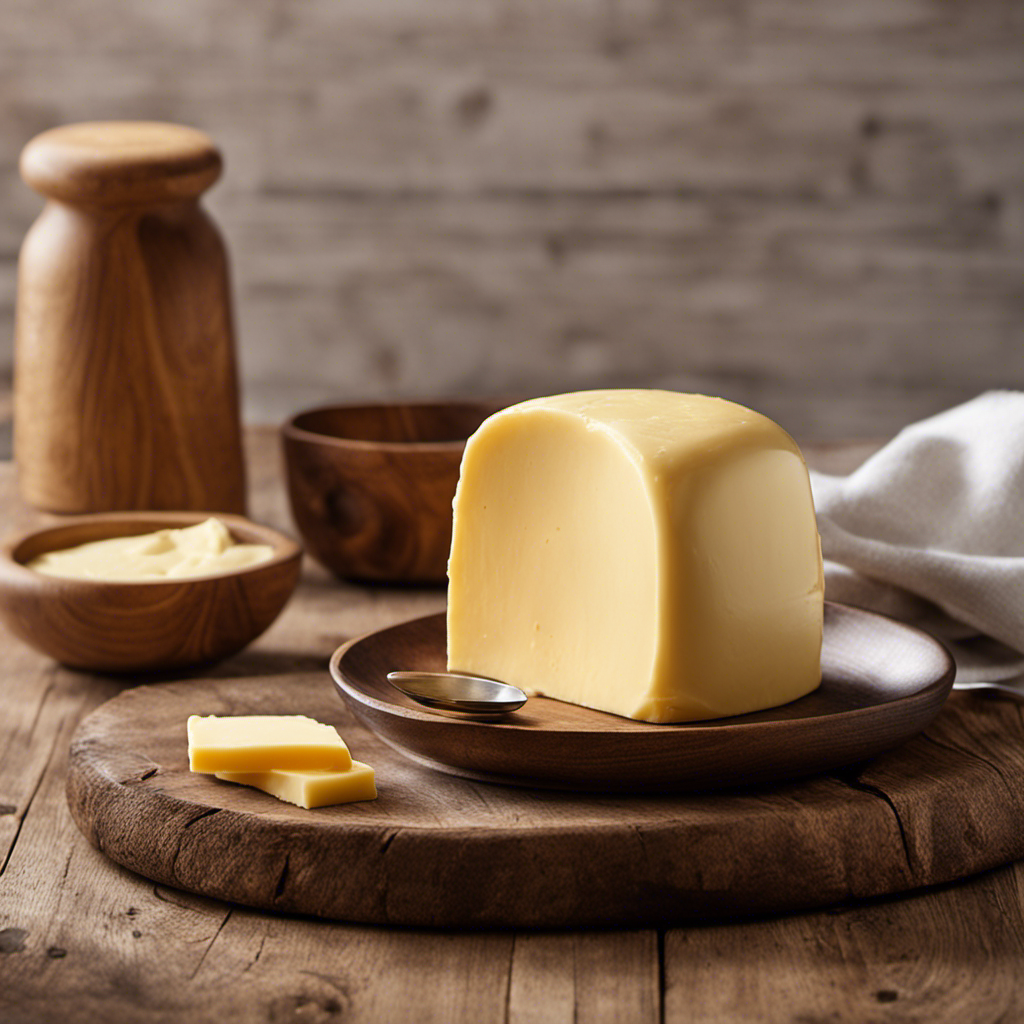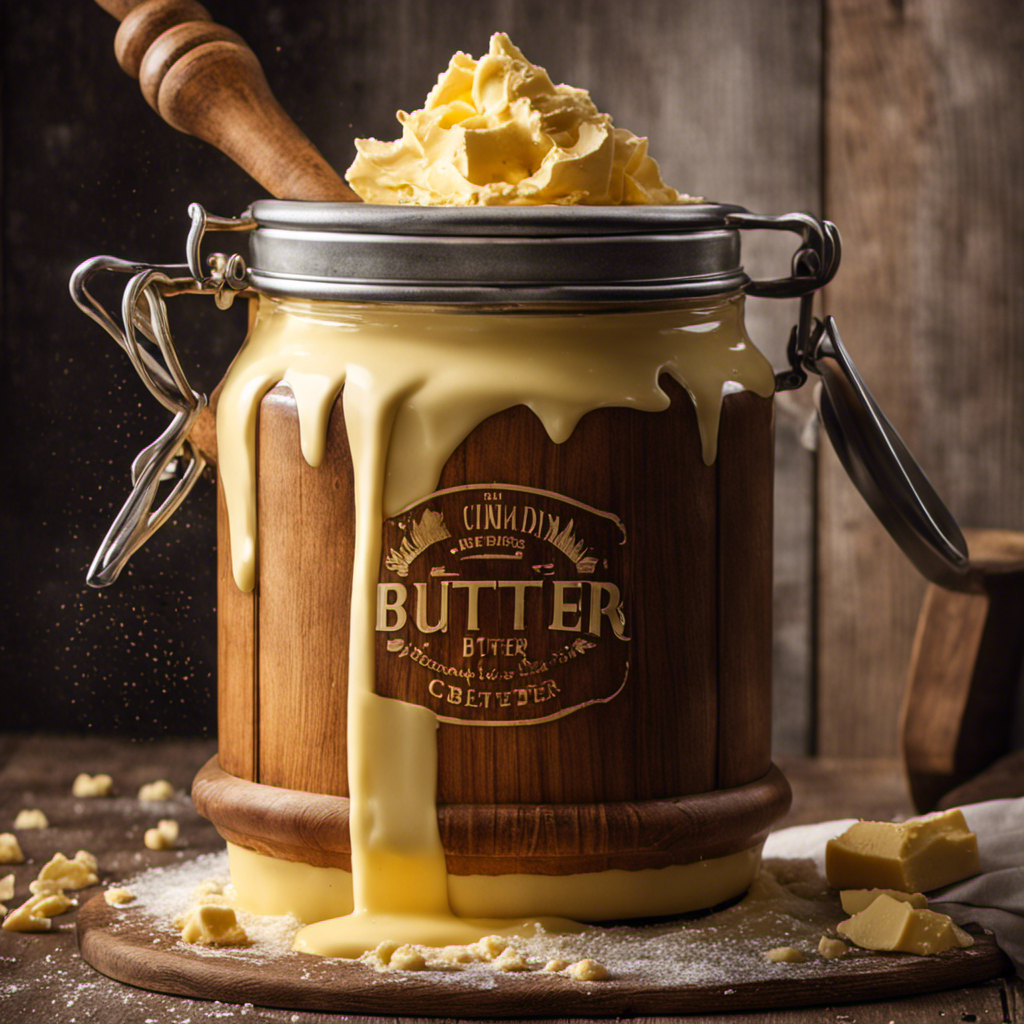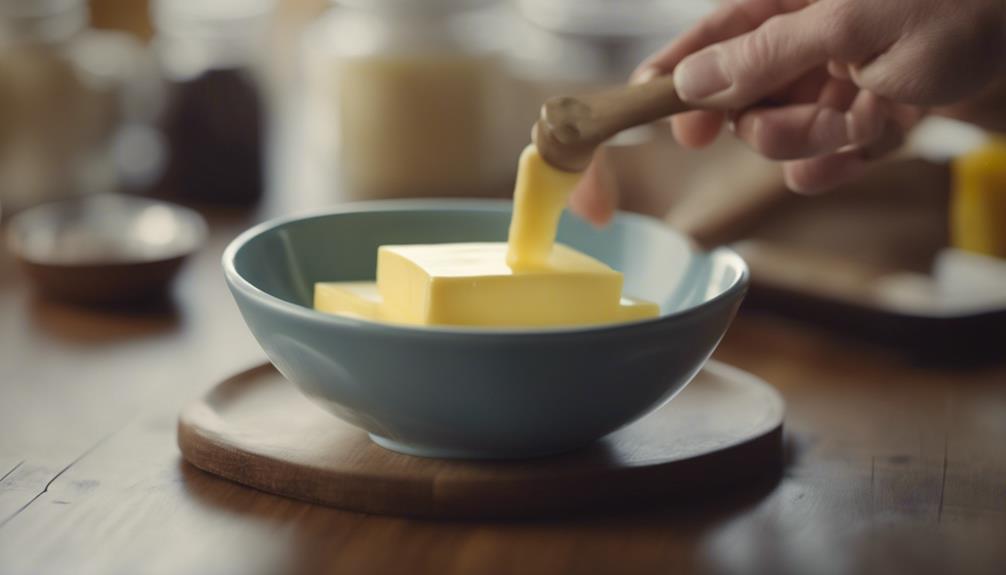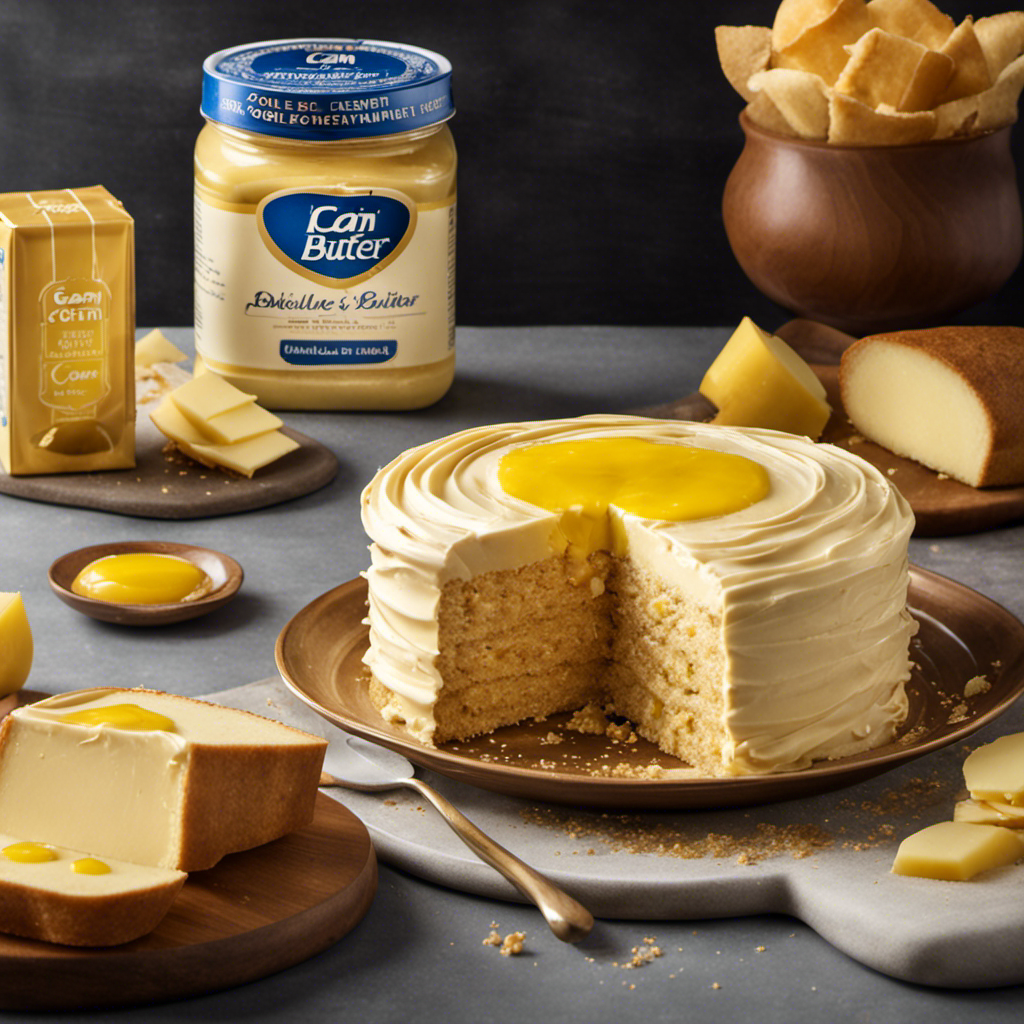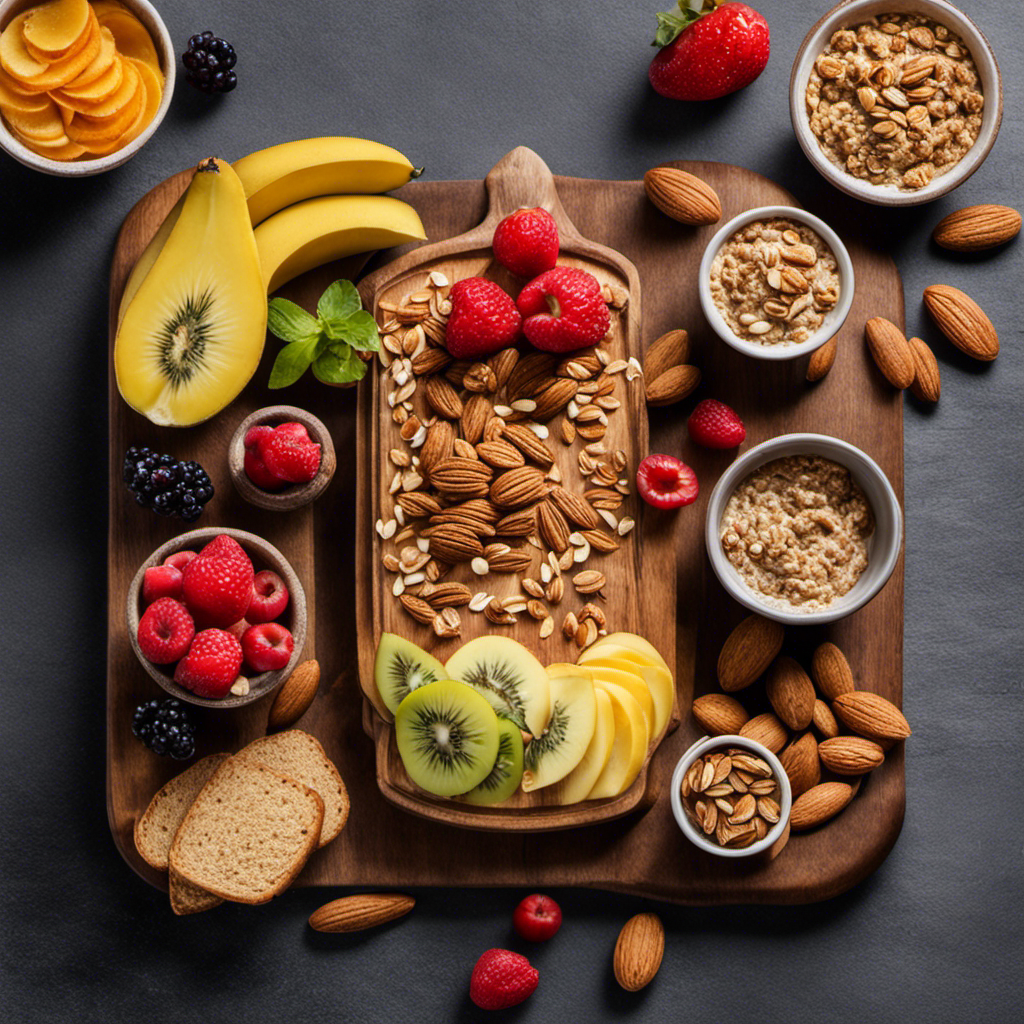Are you interested in learning about the delicious butter tart? Let me inform you, my friend, that it is a heavenly treat that comes from Canada.
This delectable Canadian treat is a gooey, sweet pastry filled with a rich, buttery filling that will make your taste buds sing.
In this article, we’ll delve into the origins of the butter tart, explore different variations of fillings, and even share tips for baking the best butter tarts.
Get ready to indulge in this mouthwatering delicacy!
Key Takeaways
- Butter tarts originated in Canada in the 18th century and were inspired by British and French tart recipes.
- The key ingredients for making butter tarts are brown sugar, eggs, and pastry dough, and variations in fillings allow for a range of flavors and textures.
- Butter tarts can be made in traditional sweet versions with butter, sugar, and eggs, or with a savory twist using ingredients like bacon or cheese.
- The texture of butter tarts can vary between gooey and firm, and personal preference plays a role in choosing between the two. Achieving the perfect butter tart crust involves considerations of flakiness, crumbliness, and the choice between butter and shortening crust.
Origins of the Butter Tart
The origins of the butter tart can be traced back to early Canadian settlers in the 18th century. These delicious pastries have become an iconic part of Canadian cuisine and hold a special place in the hearts of many Canadians.
The exact origins of the butter tart are unclear, but it is believed to have been inspired by British and French tart recipes. The unique combination of butter, sugar, and eggs creates a rich and gooey filling that is often complemented with raisins or pecans.
The butter tart has deep cultural significance in Canada, symbolizing the country’s history and culinary heritage. It is often enjoyed during special occasions, such as Canada Day or Thanksgiving, and has become a cherished treat that brings people together.
Ingredients Used in a Butter Tart
To make a delicious butter tart, you’ll need some key ingredients like brown sugar, eggs, and pastry dough. The filling variations for butter tarts are endless, allowing for a range of flavors and textures. Some popular options include adding raisins, pecans, or even chocolate chips to the filling mixture. For a gooey and sweet filling, make sure to use a combination of butter, brown sugar, and corn syrup.
To achieve the perfect butter tart, it’s important to pay attention to the details. Be sure to fully pre-bake the pastry shells to avoid a soggy bottom. Additionally, make sure to properly mix the filling ingredients to ensure a smooth and creamy texture. With these tips in mind, you’ll be well on your way to making the perfect butter tart.
Now, let’s explore the differences between traditional and modern butter tart recipes.
Traditional Vs. Modern Butter Tart Recipes
When it comes to butter tarts, flavor preferences can vary greatly between sweet and savory. Some people prefer the classic sweet version, with a gooey filling made from butter, sugar, and eggs, while others enjoy a savory twist with ingredients like bacon or cheese.
Texture is another important aspect, with some preferring a gooey and sticky filling, while others prefer a firmer and less runny texture.
Understanding these flavor preferences and texture differences can help in creating traditional and modern butter tart recipes that cater to a variety of tastes.
Flavor Preferences: Sweet Vs. Savory
If you’re a fan of sweet treats, you’ll likely prefer the classic sweet butter tart over its savory counterpart. However, savory butter tart recipes are gaining popularity for those looking for a different twist on this traditional pastry.
Here are three reasons why you might want to give savory butter tarts a try:
-
Unique flavor combinations: Savory butter tarts offer a whole new world of flavors. Imagine a buttery tart shell filled with a savory mixture of cheese, herbs, and vegetables. The combination of savory ingredients creates a delicious and satisfying taste experience.
-
Versatile options: With savory butter tarts, you have endless possibilities for fillings. You can experiment with different cheeses, meats, and vegetables to create your own unique flavor profile. From bacon and cheddar to spinach and feta, the options are limitless.
-
Health benefits: While sweet butter tarts are undeniably delicious, they tend to be high in sugar and calories. On the other hand, savory butter tarts can be a healthier option as they often contain more vegetables and protein. By choosing savory over sweet, you can indulge in a treat while still enjoying some nutritional benefits.
Texture Differences: Gooey Vs. Firm
For a unique taste experience, try the gooey texture of a sweet butter tart or the firm texture of a savory one.
When it comes to butter tarts, the texture can greatly impact the overall enjoyment of this beloved Canadian treat. The question of whether gooey or firm is more popular largely depends on personal preference.
Some people prefer the gooey texture because it offers a melt-in-your-mouth experience. The filling is soft and sticky, with a rich and sweet taste.
On the other hand, others enjoy the firm texture of a butter tart. The filling is more solid and holds its shape, providing a satisfying bite.
The texture differences can greatly impact the overall enjoyment of a butter tart, as it adds another layer of sensory experience to the taste.
Ultimately, it is up to the individual to decide which texture they prefer.
The Perfect Butter Tart Crust
When it comes to making the perfect butter tart crust, there are two important factors to consider: flakiness and crumbliness.
Both qualities contribute to the overall texture and taste of the tart.
In terms of flakiness, a crust made with butter tends to have a lighter and more delicate texture, while a crust made with shortening tends to be denser and less flaky.
As for crumbliness, a butter crust has a tendency to crumble more easily, giving it a tender and melt-in-your-mouth quality, while a shortening crust holds its shape better and provides a sturdier base for the filling.
Flaky Vs. Crumbly Crust
To achieve a flaky crust for your butter tart, make sure to use cold butter and handle the dough gently. Flaky crusts are characterized by their light and airy texture, which adds a delightful contrast to the sweet and gooey filling. Here are three tips to achieve a perfect flaky crust:
-
Use cold butter: When making the dough, it’s crucial to use cold butter. The cold temperature helps create layers in the crust, resulting in a flaky texture when baked.
-
Handle the dough gently: Overworking the dough can lead to a tough crust. Handle it as little as possible to avoid developing gluten, which can make the crust dense and crumbly.
-
Chill the dough: After shaping the dough into a disk, refrigerate it for at least 30 minutes. This allows the butter to solidify again, ensuring a flaky crust when baked.
Butter Vs. Shortening Crust
Achieving a flaky crust can be done by using shortening instead of butter. While butter adds a rich and flavorful taste to the crust, shortening has its own advantages.
Shortening has a higher melting point than butter, which means it takes longer to melt in the oven. This results in a flakier texture, as the shortening creates pockets of air when it melts, giving the crust a light and airy feel.
Additionally, shortening has a neutral flavor, allowing the filling to be the star of the show. Butter, on the other hand, adds a distinct and delicious taste to the crust. It lends a buttery and slightly savory flavor that complements a variety of fillings.
Ultimately, the choice between butter and shortening depends on personal preference and the desired outcome of the crust.
Variations of Butter Tart Fillings
There’s no limit to the delicious variations of fillings you can try in a butter tart! The beauty of this classic Canadian treat is that it can be customized to suit any taste preference.
Here are three unique flavor combinations to inspire your next batch of butter tarts:
-
Maple Pecan: Add a Canadian twist to your butter tarts by incorporating maple syrup and chopped pecans into the filling. The rich, sweet maple flavor pairs perfectly with the nuttiness of the pecans.
-
Salted Caramel: Elevate your butter tarts by adding a touch of salted caramel to the filling. The combination of sweet and salty creates a delectable balance of flavors that is sure to impress.
-
Chocolate Raspberry: For a decadent twist, mix in some melted chocolate and fresh raspberries into the filling. The rich chocolate complements the tartness of the raspberries, creating a delightful taste sensation.
Get creative and experiment with different flavors to discover your own unique butter tart masterpiece!
Tips for Baking the Best Butter Tarts
For the best results, make sure you preheat the oven before baking your butter tarts. Achieving a flaky crust is essential for these delectable treats. Here are a few tips to help you achieve that perfect flaky texture:
-
Use cold ingredients: Cold butter and cold water are key to creating a flaky crust. The cold butter creates small pockets of steam, which helps create the flakiness.
-
Don’t overwork the dough: A light touch is important when mixing the ingredients together. Overworking the dough can make it tough and less flaky.
-
Chill the dough: After preparing the dough, refrigerate it for at least 30 minutes. This allows the butter to firm up and relax the gluten in the flour, resulting in a flakier crust.
-
Blind bake the crust: To prevent a soggy bottom, blind bake the crust before adding the filling. This involves partially baking the crust without the filling.
Now, let’s talk about the filling variations you can try with your butter tarts. Here is a table showcasing some popular options:
| Filling Variation | Description |
|---|---|
| Classic | Made with butter, brown sugar, eggs, and vanilla, this is the traditional filling that is sweet and gooey. |
| Pecan | Adding chopped pecans to the classic filling adds a delightful crunch and nutty flavor. |
| Maple | Replace the brown sugar with pure maple syrup for a rich and distinctively Canadian twist. |
| Chocolate | Add melted chocolate to the classic filling for a decadent and indulgent treat. |
With these tips and filling variations, you’ll be well on your way to baking the best butter tarts. Enjoy!
Butter Tarts: A Canadian Delicacy
Now let’s explore why these Canadian treats have become such a beloved delicacy in the country.
-
Rich History: Butter tarts have a long-standing tradition in Canadian baking. The recipe is said to have originated from the early settlers in Ontario and Quebec. These delicious pastries were often made with simple ingredients that were readily available, such as butter, sugar, and eggs.
-
Sweet and gooey: The main attraction of a butter tart is its filling. The combination of butter, sugar, and eggs creates a sweet and gooey center that oozes with every bite. The contrast between the sticky filling and the flaky pastry shell is simply irresistible.
-
Versatility: Butter tarts are incredibly versatile. While the classic recipe calls for raisins, you can easily customize the filling to your liking. From pecans to chocolate chips, the options are endless. This versatility allows bakers to get creative and put their own spin on the traditional Canadian pastry.
In conclusion, butter tarts have become a beloved delicacy in Canada due to their rich history, sweet and gooey filling, and versatility in customization.
Butter Tarts in Popular Culture
If you’re a fan of Canadian treats, you’ve probably noticed butter tarts making appearances in popular culture. These delectable desserts have become a staple not only in Canadian cuisine but also in film and literature.
In the 2007 film ‘Away from Her,’ butter tarts are featured as a symbol of comfort and home. Alice Munro, a celebrated Canadian author, often mentions butter tarts in her stories as a nostalgic reminder of her childhood. These references highlight the cultural significance of butter tarts and their ability to evoke feelings of warmth and tradition.
From the silver screen to the pages of a book, butter tarts continue to captivate audiences with their irresistible charm. Now, let’s explore how to enjoy butter tarts all year round.
How to Enjoy Butter Tarts All Year Round
You can savor the sweet taste of these delightful treats no matter the season. Butter tarts are not just limited to being enjoyed on their own; they can also be incorporated into various desserts for a unique twist.
Here are three ways to enjoy butter tarts in different desserts:
-
Butter Tart Cheesecake: Combine the rich flavors of butter tarts with a creamy cheesecake base. Simply crumble some butter tarts and mix them into the cheesecake batter before baking. The result is a decadent dessert that will impress your guests at any special occasion.
-
Butter Tart Ice Cream Sundae: Scoop some vanilla ice cream into a bowl and top it with chopped butter tarts, caramel sauce, and a sprinkle of pecans. The combination of cold, creamy ice cream with the gooey sweetness of butter tarts creates a delightful dessert that is perfect for summer.
-
Butter Tart Trifle: Layer pieces of butter tart with whipped cream and fresh berries in a glass trifle dish. Repeat the layers until the dish is full and garnish with a drizzle of caramel sauce. This elegant dessert is sure to be a showstopper at any dinner party.
With these creative ways to incorporate butter tarts into different desserts, you can enjoy the classic Canadian treat all year round and make it the star of any special occasion.
Frequently Asked Questions
Can I Substitute the Butter in a Butter Tart Recipe With a Different Ingredient?
Yes, you can substitute the butter in a butter tart recipe with a different ingredient. There are several alternatives to butter for baking, such as margarine or coconut oil, that can be used instead.
Are Butter Tarts Suitable for People With Dietary Restrictions, Such as Those Following a Gluten-Free or Vegan Diet?
Butter tarts can be made suitable for people with dietary restrictions. There are gluten-free alternatives available, and vegan butter tart recipes that use plant-based ingredients instead. It’s important to find the right substitutes for a delicious and inclusive treat.
How Long Can I Store Butter Tarts Before They Go Bad?
When it comes to storing butter tarts, it’s important to keep them in an airtight container at room temperature. They can last for up to a week, but they’re best enjoyed within the first few days.
Can I Freeze Butter Tarts for Later Consumption?
Sure, you can freeze butter tarts for later enjoyment. Just make sure they are completely cooled before freezing. As for variations, you can try adding raisins, pecans, or even chocolate chips to your butter tart recipe.
Are There Any Regional Variations of Butter Tarts in Canada?
Regional variations of butter tarts in Canada are fascinating. From Ontario’s classic gooey filling to Quebec’s pecan twist, each province adds its unique touch. These variations showcase the cultural significance and creativity behind this beloved Canadian treat.
Conclusion
In conclusion, butter tarts are a delectable Canadian treat that is sure to satisfy any sweet tooth. With their flaky crust and gooey filling, these little delights transport you to a cozy kitchen, filled with the warm aroma of butter and sugar.
Whether enjoyed on a snowy winter day or at a summer picnic, butter tarts are a true taste of Canadian heritage. So next time you’re craving a delightful dessert, indulge in the buttery goodness of a homemade butter tart and experience a little slice of Canadian culinary tradition.

